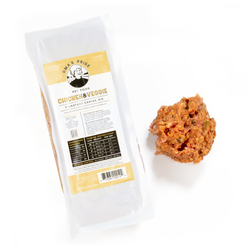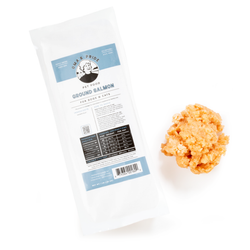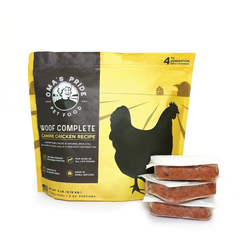Raw Bones for Dogs 101: All You Need to Know
The terms dog and bone go hand-in-hand.
We use the idiom, “Give a dog a bone,” and see plush toy bones sold at pet stores. Even every cartoon dog seems to have a bone nearby.
Why is this?
…because a dog with a bone is as natural as it gets!
In this article, we’ll discuss the importance of raw bones, the difference between recreational and edible bones, and safety precautions.
Raw bones for dogs are essential because they support digestion, clean teeth, mentally stimulate, strengthen the jaw and mouth, ease anxiety, and provide essential nutrients like calcium. In general, your dog’s diet should include about 10-15% edible bone; you can also feed recreational bones 1-2 times a week.


Table of contents
- Definition
- The benefits of bones for dogs
- All about edible bones
- All about recreational bones
- Safety precautions
- Where you can purchase bones
- Frequently asked questions
Explore Products
What are raw bones for dogs?
There are two main categories of raw bones (and each one serves a distinct purpose):
Edible bones. These are raw, uncooked pieces of meat, bone, tissue, and cartilage that carnivorous dogs eat to meet the nutritional requirement for bone content. These cuts of meat come from animals like chicken, quail, duck, rabbit, turkey, or pork.
Edible bones, also known as raw meaty bones (RMBs), help raw feeders meet dietary requirements for phosphorus, calcium, and other minerals.
Recreational bones. These are raw, uncooked bones intended for chewing (but not eating whole). They are typically filled with marrow and covered in a small amount of meat and tissue. Dogs that eat raw or kibble can chew on them as a supplement.
Recreational bones come from larger animals, such as bison, cow, elk, moose, deer, or buffalo. We typically source them from larger, more robust areas, such as the knuckle, femur, shank, rib, tibia, or hip.
The benefits of raw bones for dogs
Bones are tremendously important for dogs, both as a part of their diet and as a way to provide mental stimulation.
Benefits of edible bones
- Promotes healthy digestion. Bone content, made from tissues and fibers, binds to food in the digestive tract to improve digestion and prevent runny stools.
- Provides essential minerals. When dogs eat raw meaty bones, they obtain minerals such as calcium and phosphorus from them. These essential minerals are vital for maintaining teeth and bone strength, as well as supporting organ and tissue function throughout the body.

Benefits of all bones
- Natural release for carnivores. Carnivores naturally desire to chew, so gnawing provides crucial mental stimulation. They enjoy the challenge of ripping and tearing (it’s like a fun puzzle); this stimulation releases endorphins, keeping them from chewing on other unwanted objects when bored.
- Exercises the jaw and mouth. Your dog can keep their mouth, jaw, neck, and shoulders strong by chewing on an edible or recreational bone.
- Cleans teeth by removing tartar and plaque. Bones are the most natural way to keep your dog’s teeth clean and fight the development of gum disease. Gnawing and chewing remove plaque and tartar buildup, keeping the teeth and gums clean.
- Relieves pain for teething puppies. Puppies experience painful teething as they grow their adult teeth. During this time, give them a bone to chew on to relieve pain and reduce anxiety.
- A healthy alternative to rawhide. Many pet parents are aware of the dangers of rawhide—a difficult-to-digest chew made from chemicals and leather byproducts that can cause blockages or choking. Recreational and raw meaty bones are a natural, safer alternative to entertain dogs and clean their teeth.
Going deeper: all about edible bones
Edible raw bones, given to dogs as part of a balanced diet, provide essential nutrients and minerals, such as phosphorus and calcium. These bony animal pieces (with meat and tissue attached) also contain protein, iron, collagen, essential fatty acids, vitamins, and amino acids.
Edible bones are softer, more hollow, and covered in meaty tissue and cartilage. Many raw feeders prefer poultry bones because they are smaller and softer.
Keep in mind that not all bones are suitable to eat raw and whole (even from poultry). For example, weight-bearing bones are larger and more likely to splinter, so you should not feed these as RMBs.


How to get started with edible bones
If you are transitioning your dog from kibble to raw, we recommend waiting 7-10 days before introducing RMBs into the diet.
Please note! While raw meaty bones are great for many dogs, they aren’t for every dog. Dogs with weakened enamel or other compromising dental issues, overly aggressive chewers, or even dogs without a desire to chew won’t do well with RMBs. See alternatives below.
When you begin, start slow with smaller pieces, like a duck foot, then gradually increase the size of the RMB to match your dog’s size.
You’ll want to first thaw the bone from the freezer to the fridge for 24 hours before serving. Then, place the RMB in your dog’s bowl, ensuring they have an appropriate place to chew. If you’re worried about a mess, place the bowl on a towel or outside on a surface that can be easily cleaned or wiped afterward.

How to calculate bone percentage
It can be overwhelming when you’re just getting started with raw feeding. However, with a few calculations, you can feel confident that your pup is getting the right amount of bone content in their meals by balancing phosphorus and calcium (around a 1:1 ratio).
Raw feeding tip! As a good rule of thumb, bones should make up about 10-15% of your dog’s overall raw diet.
Each edible bone has a different percentage of bone content. For example, a turkey neck contains about 45% bone, while a chicken foot contains about 60% bone. (View the bone content of various RMBs here.)
Here’s how to calculate how much to feed:
Step 1: Select a raw, meaty bone. For this example, we'll use Whole Chicken Necks.
Step 2: Calculate the amount of raw dog food your dog needs. My dog, Lyra, is at a maintenance weight of 50 pounds. Generally, it’s good to feed around 2.5% of body weight in food per day. Therefore, she requires approximately 1.25 pounds of food per day.
Step 3: Calculate how much bone to feed. I’m going to feed skinless chicken necks (about 60% bone). By giving her 0.3 pounds of chicken necks (0.3 ÷ 1.25 = 24% of her overall diet), she’ll get around 14.4% bone in her diet per day (derived from 60 x 0.24).
While these are general guidelines, monitoring your pet’s poop to adjust bone content is important. Harder, chalky, or white stool indicates too much bone content, while water or loose stool can indicate insufficient bone content.
Alternatives to whole raw meaty bones
- Green tripe. Like RMBs, green tripe has a balanced ratio of calcium and phosphorus (around 1:1) needed for a balanced diet. Learn more about tripe here.
- Other supplements. You can also purchase food-grade bone meal (ideally not heated) made for pet consumption. Some companies sell seaweed or coral calcium, but it is essential to correctly balance calcium and phosphorus levels. A great alternative: freeze-dried beef bones from Dogs Naturally Magazine called Four Leaf Rover “Better Bones.”
- Ground meat and bone mixes. You can purchase raw mixes that include ground bone in them, so your pup can get the benefits of bone without needing to chew on an RMB.
Appropriate edible bones (based on pet size)
It’s essential to understand what bones your dog can eat (based on their size) and how much they can consume.
- Necks. Dogs and cats of all sizes can eat chicken necks. Duck necks are better suited for medium-sized dogs, while turkey necks are ideal for larger dogs.
- Whole animal. Whole sardines, mackerel, and quail are appropriate for all sizes of dogs and cats.
- Wings. The wingette, wing tip, and drumette of chickens are suitable for all sizes. Duck wings are appropriate for medium-sized dogs and up. Turkey wings are appropriate for large dogs (we recommend removing the drumette first because of its density).
- Feet. Chicken and duck feet are great for all pets because they contain a lot of tissue and ligaments. Pork feet are more appropriate for large dogs (but are high in fat, so feed in moderation).
- Frames. You can feed chicken and duck frames to pets of all sizes.
- Tails. Larger tails from pigs, turkeys, goats, lambs, or oxen are best for medium-sized dogs and up. However, if you find a smaller tail, some smaller pets will do fine with them.
- Ribs. Lamb or pork ribs should be reserved for large dogs.

Going deeper: all about recreational bones
Recreational bones are not meant to be eaten whole (only chewed on) because they are larger and harder than edible bones.
When feeding, it’s essential to select the correct size so your dog doesn’t hurt themselves or try to eat the bone whole. For example, larger marrow and knuckle bones are suitable for medium to large dogs, while smaller rib bones are more suitable for smaller animals.
Important note! Recreational bones cannot replace bone meal or raw meaty bones in your dog’s diet because they don’t provide suitable amounts of phosphorous or calcium. Think of these as a treat rather than a meal.
Types of recreational bones
Recreational bones are made from large, weight-bearing bones found in cows, buffalo, bison, elk, deer, or moose. Cuts typically come from the animal's femur, tibia, shank, or hip areas.
How to feed recreational bones
When you’re ready to give your dog a bone, simply grab a bone from the freezer. You can wait for it to thaw a bit or give it to your pup immediately if they are a less aggressive chewer.
It’s best to feed raw beef marrow bones for about 20 minutes at a time, 1-2 times per week. Marrow is fatty and can cause digestive upset if eaten too frequently.
Here are some tips to make this the best possible experience:
- Choose the right location and setting. Dogs can make a mess while chewing raw bones. Feed them in an ideal location—outside, on a towel, or on another surface that can be sanitized easily. Avoid distracting situations (such as being around new dogs or people) to reduce resource-guarding behaviors.
- Teach the command, "Drop It." Ensure your dog knows the "drop it" command in case something unsafe occurs. This command will enable you to take control of the situation safely, if necessary.
- Feed after a meal. Giving your dog a recreational bone after a full meal helps prevent aggressive chewing, as they are less likely to overindulge.
- Use them as an exercise alternative. Recreational bones can serve as a great alternative when exercise is not possible, such as during extreme weather. They will keep your dog occupied and mentally stimulated.
- Follow safe raw food handling techniques. Always wash your hands after handling raw bones, sanitize surfaces, and store the bones in the fridge or freezer after each feeding session to ensure safety.
Safety precautions
Although feeding bones to dogs is generally safe, it’s always a good idea to be proactive and understand the risks associated with this activity.
First, it is essential to understand what your dog can and cannot handle, based on their chewing habits, temperament, and other factors. We recommend starting slow with smaller pieces, then building up to eating whole bones once you feel comfortable with it.
Although rare, choking, splintering, and blockages can occur with raw bones. That's why you must monitor your dog while they chew so you can intervene.
Safety tip! Do not feed cooked, smoked, roasted, boiled, or heat-processed bones because they are known to splinter and harm dogs’ teeth. Heating bones removes the moisture, causing them to harden and become brittle.
Where you can purchase bones
Now, you may be wondering, “Where can I buy raw bones for my dogs?”
Generally speaking, the best place to source bones from is an online pet retailer, a local farmer’s market, a local raw co-op, or a butcher.
Please note that a butcher must know how to process the bones for canine consumption (as standard machine-cut bones not prepared for eating raw can have sharp, dangerous edges).
Additionally, we don’t recommend feeding dogs raw bones or meat from the grocery store, as they are stored at refrigerated temperatures that can foster bacterial growth. These grocery store meats are meant to be fully cooked before consumption.
Frequently asked questions
Can dogs eat bones?
Yes, most dogs can eat whole raw meaty bones and recreational bones as part of a balanced diet. However, whole bones may not be ideal for dogs that are overly aggressive or have dental problems.
Are raw bones safe for dogs?
Yes, raw bones are safe for dogs if you feed an appropriate-sized bone, monitor your dog closely as they chew, and source the bone from a trusted pet retailer, local raw co-op, or butcher.
Comments
Jim
Aug 28, 2025 at 01:32pm
I been feeding my 6 mos old Corso chicken qtrs, I would split it into the thigh & drumstick as he can chew those up good however I noticed a small bone about 2 inches in his poo this morning . Is this normal? I not sure.
Leave a comment
Your email address will not be published. Required fields are marked with *























Oma's Pride
Aug 28, 2025 at 01:34pm
Hi Jim,
Thanks for sharing your experience with your pup! At 6 months, it’s normal for puppies to still be learning how to properly chew and digest raw meaty bones. It’s not unusual to occasionally see small, soft bone fragments in the stool. This often means the body didn’t fully break them down, which can happen from time to time. A few tips:
1. Monitor bone size & density. Stick to raw bones (like chicken bones) that are the appropriate size for your puppy. Chicken quarters are usually okay. When splitting the thigh and drumstick, ensure you split it at the joint so you don’t create sharp pieces.
2. Supervise chewing sessions. Make sure your pup is chewing and taking his time (not gulping pieces down whole).
3. Watch for warning signs. If you ever notice consistently hard, dry stools, constipation, vomiting, or discomfort, it’s best to pause bones and check in with your holistic vet.
It’s normal for your pup to see small soft fragments in stool as long as your puppy is not showing any other signs of discomfort or digestive upset. However, if you start seeing large, sharp, or jagged bone pieces passing through undigested, blood in stools, or any other signs of discomfort, we would recommend pausing and speaking to a holistic vet.
Every dog is different when it comes to how well they digest bones. You’re doing a great job being attentive to your Corso’s health, and we’re happy to be a resource if you have more questions!